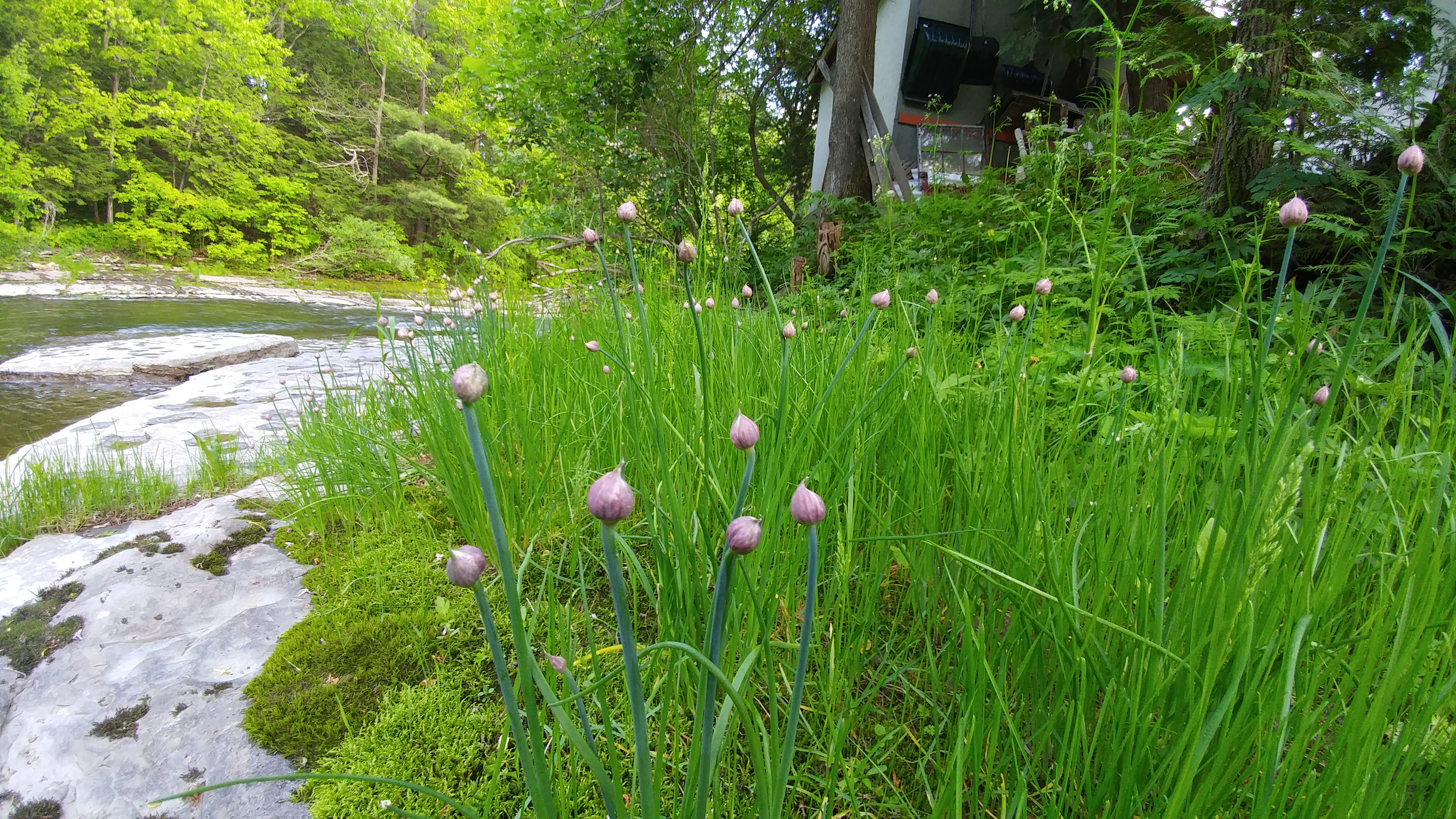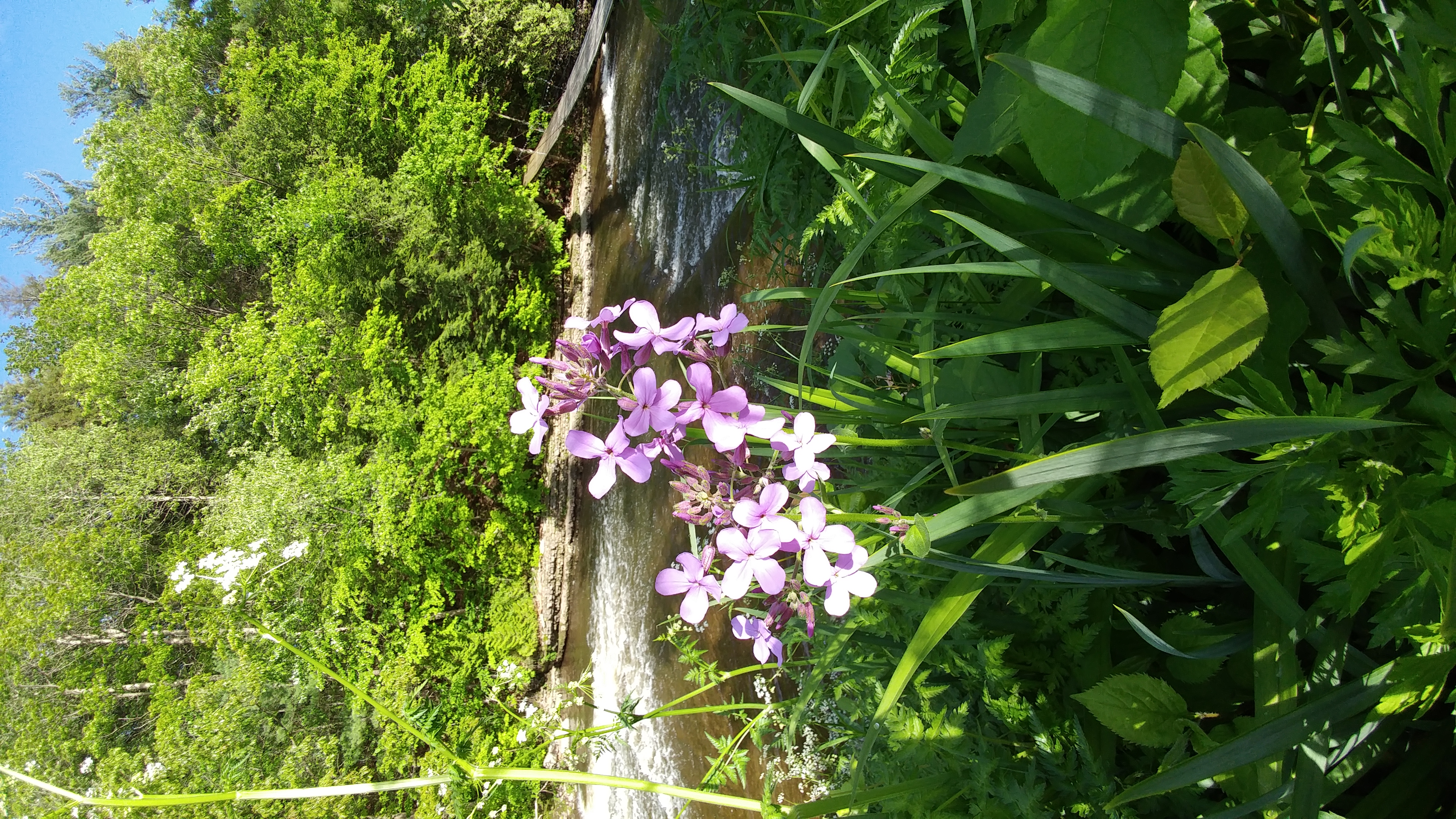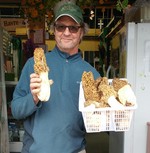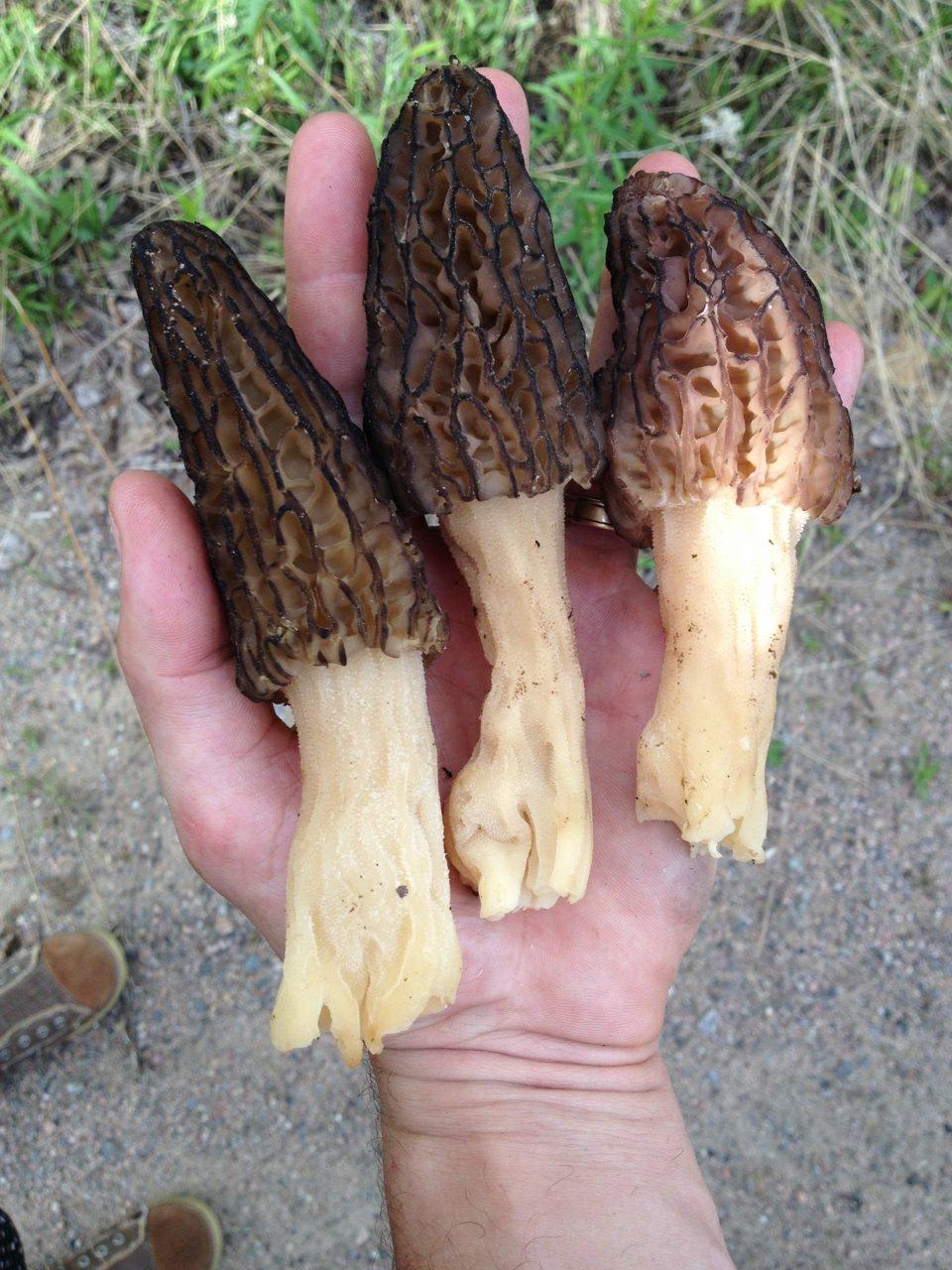Entries in spring wild edibles (3)
Têtes de Violon
Têtes de violon(Fiddleheads)- pur délice de printemps
Nancy Hinton, Les Jardins Sauvages

Et oui, c’est déjà bientôt ce temps de l’année! L’arrivée des têtes de violon est toujours un moment festif chez nous, vedette du printemps - notre premier légume vert de terroir, si nutritif et délicieux quand bien choisi et apprêté. Ce qui débute la saison de récoltes et de bien manger local plus facilement, yé.
La bonne nouvelle c’est qu’il ne faut pas avoir peur de ce bon comestible forestier! Malgré la mauvaise presse et controverse dans le passé. On dirait qu’on recommence à chaque année avec éducation face à de l’information confuse qui circule, quand ce n’est pas si compliqué. C’est juste une question de qualité, fraicheur et de cuisson. Les seuls cas de malaise documentés ont été dû à de la consommation crue et sources particulières/inconnues. François en cueille dans nos sites de façon durable sans probleme depuis tant d'années. (37 ans officiellement)
Les têtes de violon nous offre un cocktail impressionnant de nutriments comme les Vitamin A et C, des anti-oxydants et minéraux essentiels (le fer, calcium, magnésium, potassium, Cu et Ma), protéines et fibres.. Elles contiennent également une molécule qui peut être indigeste – le ptaquiloside, mais qui est soluble dans l’eau et dénaturé par la chaleur. Alors si lavées et cuites, il n’y a pas de soucis! Et vu qu’elles poussent au long des rivières, cela protège contre les bactéries aussi.
Aussi, la réalité c’est qu’il y a beaucoup de variabilité de qualité et de fraicheur sur le marché, incluant beaucoup de marché noir et de cueilleurs improvisés, opérant en dehors de chaine de réfrigération et normes d’hygiène et salubrité, sans traçabilité. Souvent ce qu’on trouve à l’épicerie par exemple est un lot qui a été dompé sur le marché à bas prix comme les commerçants préfèrent, parce que le cueilleur sans chambre froide et réseau veut s’en débarrasser. Un cueilleur/entreprise enregistrée avec des normes et couts d’opération ne peut pas compétitionner le marché noir sur le prix, mais certainement sur la qualité.
Bref, on a simplement à s’assurer d’une bonne source fraichement cueillie et bien entreposé, les laver et cuire dans beaucoup d’eau bouillante. Il ne faut pas les manger cru, c’est tout!
Cuisson : Avec une belle qualité de têtes de violon (comme les nôtres) et suffisamment d’eau dans le chaudron, 5 min dans l’eau bouillante c’est assez pour que les têtes soient cuites au centre et tendres... Avant des introduire à vos recettes. Fiche de cuisson sur notre site.
(L’histoire de cuisson à deux eaux est superflue à moins que vous ayez un tout petit chaudron ou une source inconnue ou vous êtes perfectionniste visant le maximum de couleur vert et contacte d’eau avec minimum cuisson, vraiment pas nécessaire pour la digestibilité ou la délicieusité). Il y a un temps qu’on le suggérait par précaution, mais suivant ma recherche et autant d’années d’expérience depuis, j’ai conclus que c’était bien ok de sauter cet étape.
On peut les manger froides en salade après une première cuisson, mais elles sont encore meilleur chaudes. De plus, on va souvent les mettre à la poêle après avec un peu de beurre monté (beurre + eau) et assaisonnements, alors une cuisson de plus... De toutes façons, elles sont meilleures un peu plus cuits qu’‘aldenté’.
Comme la plupart des légumes verts, elles aiment l’ail, et un peu de bon gras, par exemple, une bonne huile d’olive, noix ou de tournesol, le bacon, viande et umami, ainsi que les recettes asiatiques avec tamari et sésame, ou curry-coco. En omelette, pâtes, en accompagnement, on les utilise comme une asperge ou haricot vert.
Cueillette – astuces/ à quoi faire attention
Si on est assez chanceux d’en avoir sur notre terrain ou autre terrain privé avec permission, on peut les cueillir soi-même en faisant attention. Les têtes de violon poussent dans les lieux humides en forêt, aux bords de rivière et zones inondés. Fin avril début - mai au Québec. Il faut s’assurer de bien identifier l’espèce de fougère comestible (Matteuccia struthiopteris) car il y en a plusieurs, avec l’aide de personne expérimenté et livres de référence comme ‘Plantes Sauvages Comestibles’ de Fleurbec.
On les cueille à la main (sans couteau) quand juste sorti de terre (pas déroulé), et seulement 2-3 par plant; on laisse toujours plus qu’on cueille. Ensuite, il faut les laver pour enlever la pelure/les écailles brune à grande eau. Après, on les réfrigère jusqu’au moment de les cuisiner.
Idées - Recettes :
Notre façon préférée pour les têtes de violon est assez simple : Après la première cuisson à l’eau bouillante (5min), on les met à la poêle avec un peu de beurre/huile de choix, de l’ail et ‘épices à steak’; ensuite quelques gouttes de tamari, de sirop d’érable et de vinaigre de cidre. On les fait déguster comme ça, mais cette préparation fait un bel accompagnement pour poisson, viande, salade composé (style niçoise), pasta style primavera ou carbonara, pour garnir un poke bowl, etc...
Au resto, on les cuisine de plusières manieres selon le menu, et on fait toujours de la soupe verte, une chaudrée cremeuse avec bacon aussi. En saison, on fait nos reserves - en marinades et blanchies, congelées sous-vide pour l'hiver..
A la maison, on les aime bien en frittata, en wok de légumes et nouilles avec huile de sésame et chilli-crisp, ou en salade tiède. Je fais des vinaigrettes pour Jardin des Noix – ‘Europe’ (à l’huile de noyer noir) et ‘Asie’ (à l’huile de noisette), et les deux sont délicieuses sur les têtes de violon!
Une autre recette favorite s’agit d’oignons sués avec du lard/bacon, et un peu de bouillon/eau, sel & poivre (et bouquet garni typiquement Québécois avec laurier, thym ou sarriette & clou (ou épices à tourtière)), cuits doucement, assez longtemps. (Façon bas-du-fleuve)
Il y a plusieurs recettes sur note site. https://jardinssauvages.com/guides-fiches-de-cuisson/
Bon Appétit et Bon Printemps!
Spring meets Summer, Foraging issues and guidelines
Spring meets Summer, finally!
Although it’s still technically spring, it’s starting to feel a lot like summer. A deep, lush green abounds, a symphony of birds chirping, and yup, the mosquitoes are out in full force.
Our spring rush of harvesting shoots and fiddleheads is over. It’s always a mad dash to seize the short window and make the most of it. With a slow, cool spring, the greens were at their best - mild and crisp, delicious.
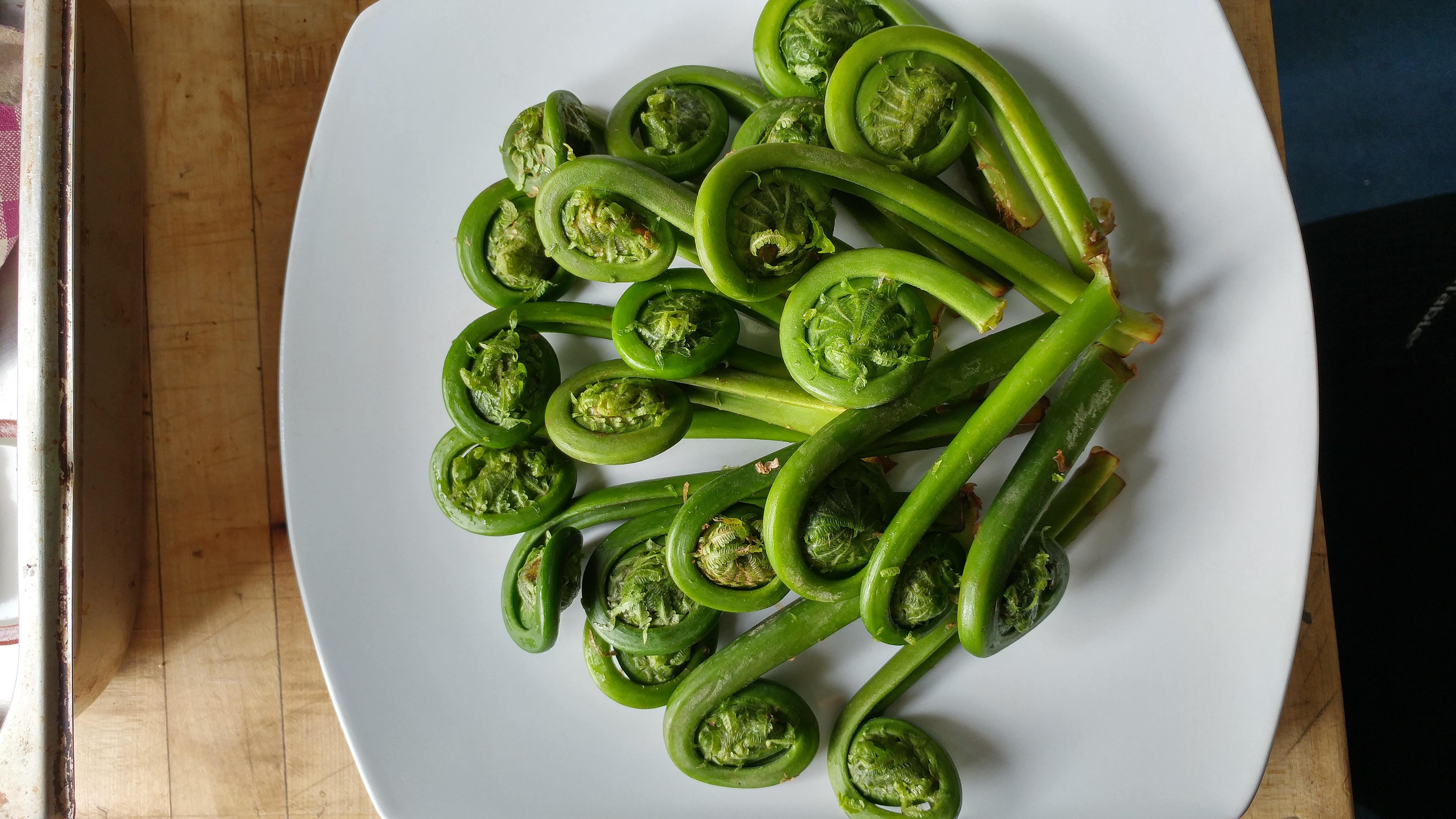 François' 'shade' fiddleheads
François' 'shade' fiddleheads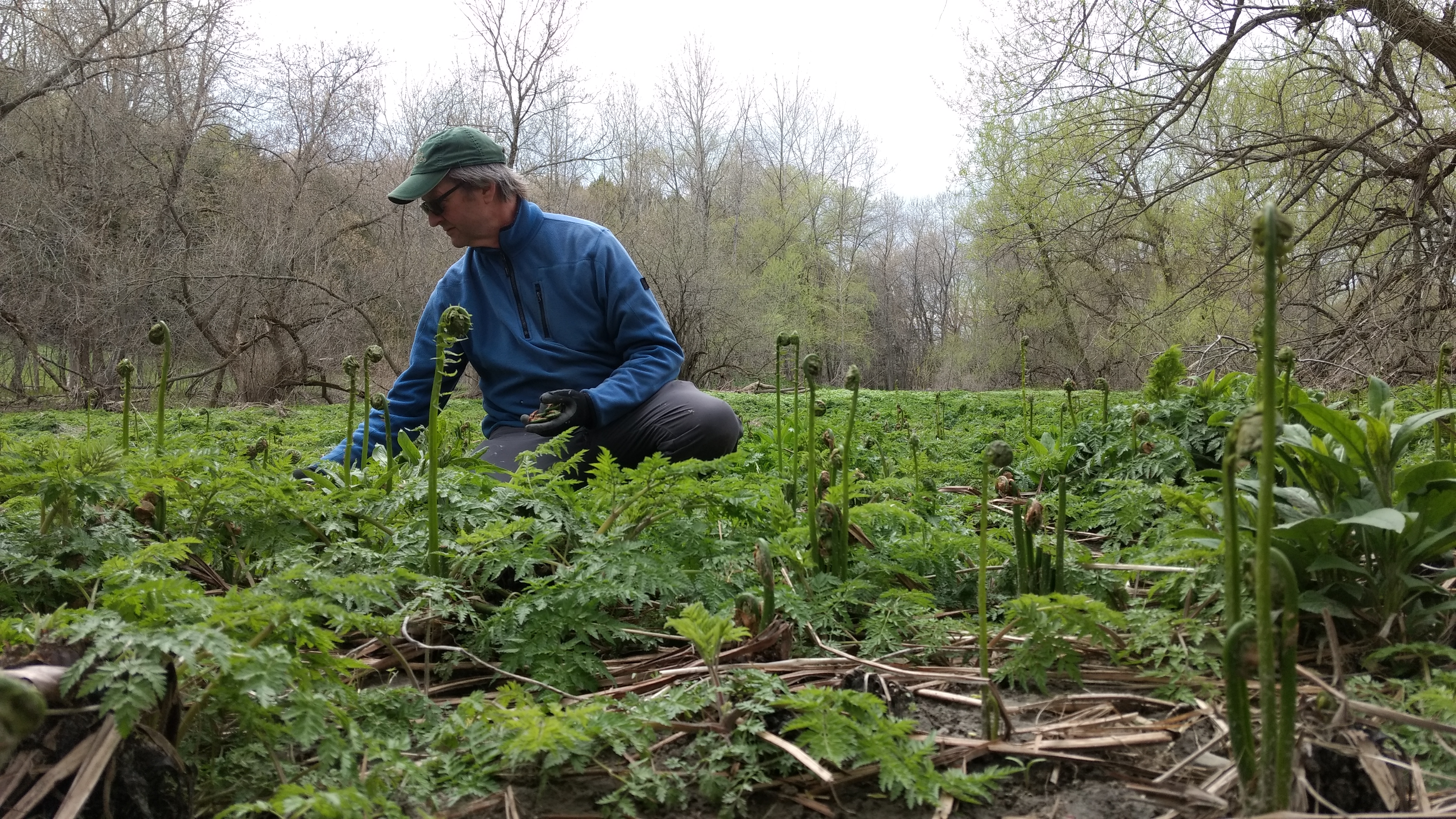
 erythrone/trout lily
erythrone/trout lily
Now, the early season stars like Trout lily, Dandelion, Spring Beauty and Linden have gone, as Stonecrop (live-forever), Daisy and Violet take their place. There is stinging nettle, garlic mustard, sheppard’s purse, wild chives and such.. as the buds appear, the edible flowers start to bloom and first marine greens pop.
It was a great morel season.
I couldn’t help but notice how many people were out there foraging and posting pictures of wild edibles this spring. It is clear that this is a trend that is only growing.
Which is great and NOT.
It’s natural that once awakened to the delights of the forest that passionate eaters and cooks want to get out there themselves. I remember my beginnings at L’Eau à la Bouche with Anne Desjardins where I met François the pioneer of foragers, how thrilling it was to discover these new ingredients. I was lucky to team up and build on his experience, taking the wild thing a step further than the chefs he'd worked with before in the Jardins Sauvages kitchen. But being leaders in largely uncharted territory meant that we had to figure a lot out on our own. Just that a certain plant is edible and best used a certain way is taken for granted now, while many years of research, tests and samples given away lie behind. Not to mention the miles walked and free labour on François' part going back 30 years. Today, it seems that every other menu resembles one of mine from 10 or 15 yrs ago, with game, wild greens & wild flavours everywhere, back when I was the only one with sweet clover or wild mushrooms in my desserts, ha. I knew we were onto something, but who knew it would ‘mushroom’ so.
For sure foraging is awesome in so many ways; it doesn’t get much more terroir, fresh and local than that. But the thing about foraging, is that it’s trickier than it appears! It is not as easy as walking through the woods and filling your basket, it is not 'free'. You need land, and knowledge, a due respect for nature and nuance, lots of time and patience, before actually putting in the hours and doing the work. Finding your spots, being there at the right time, getting down and dirty on your hands and knees with the mosquitoes. It takes more than a day or a season to learn the basics, plenty of books and time spent in the woods. Way more than a google search or utube video, say. People these days want to go too fast. It’s not that I want to discourage eager enthusiasts... But Please! I just wish everyone would be more mindful and cautious. It’s for the plants, the future and one's own sake, not only sustainablility and safety, for deliciousness too.
Foraging primer: Bottom line, Don’t touch unless you know what you’re doing..
Which means How, When and Where.
First of all, know that what you’re picking is indeed edible (there are many look alikes). Ensure that it’s a healthy population. It depends on the microclimate and age of plant population. You need to know the cycle of the plant/how hardy it is before knowing how much you can take. That’s why being in the same spots, seeing the impact of your harvest each year is so important.
Don’t rip out roots (in general). Prune.
If you pick, don’t let it show, as in you’re leaving way more than you take, little trace. Unless you are weeding your garden or in a site with an invasive plant you know well.
Be careful/don’t pick species that are slow to reproduce or endangered: Wild garlic, Wild ginger, Crinkleroot, Milkweed..
And some need to be mature enough, and then just trimmed - like sea asparagus (salicorne, samphire), otherwise you might kill the plant. This is an issue now when it is still several weeks too early to pick salicorne anywhere in Quebec. Yet, I see it on menus.
The ‘weeds’ you can worry less about, Go!: Lamb’s quarters, Nettle, Garlic Mustard, Sheppard’s purse, Purselane, Amaranthe..
And then in the kitchen, they need to be washed, and cooked properly! Some need to be cooked throughout: For instance: Fiddleheads, Milkweed, and most wild mushrooms. Wash well and boil 5min+. Less touchy veg like beach peas, goat's beard, and leafy greens like nettle might only require 1-2min. For mushrooms, a braise is better than a sauté, count 5-20min. Some greens are better raw, but most are better cooked even if slightly. All are super healthy ingredients, but can be toxic, you can’t just wing it. I’ve seen sprouts of toxic plants decorating plates in Montreal.
Don’t give wild plants a bad name by serving anything up because it sounds cool, as little do you know it might be of sketchy quality, often like those on the black market or picked without experience.. For example, dandelion is only good if picked young (before flower) in the morning; most greens like live-forever only in shady, humid conditions; garlic mustard is only yummy young/early season and same, bitter in dry conditions. Same with beech chickweed. Etc. Where, when and how was it picked/stored etc.. is key to whether it will be yummy and not give anyone a belly-ache.
With many wild plants and aromatics (herbs/spices), it’s a question of dosage.. As with nutmeg, basil or rosemary, all of which can kill you if you eat too much. The difference between delicious, medicinal and toxic is in the dose. Normally nature is well made, as in you won’t use anything potent in huge quantities - the difference between a vegetable and an herb, a stock or a sauce. For example, be careful with mélilot/sweet clover flower, sweet grass, conifers - less than .1%. . Oxalis (Lady’s sorrel), like kale and rhubarb leaves contains oxalic acid, which is hard on the kidneys. And so on.
(See more picking tips and photos/links below..)
Whether picking or not, Chefs using wild ingredients need to be responsible for their source or purchases! (See Black Market blurb below) And you can participate. There is a conference on the commerce of PFNL (wild edibles) and the development of guidelines, with chefs and journalists invited (June 14th in Quebec City), the first public meeting of the type, there will be more. It’s about developing the industry further, but in a structured and sustainable way. See below.
Rules and Regulations – they are coming, but it’s complicated
This explosion of amateur foragers and start-ups might be a plus for the economy but problematic for sustainability of the resource and market, quality and safety. Making some sort of regulation has become necessary. Which is what groups of people in the industry and levels of government are currently working on but it’s incredibly complex. Between the interests to develop the forest beyond lumber, putting people to work in the regions, sharing our heritage while balancing what is possible with respect to nature and the realities of the market, labour, what is doable and fair when it comes to enforcement... Quotas, permits?
It’s a big pain in the ass actually. We have no choice but to be implicated, because we care and have expertise to bring to the table, and obviously, it will affect us directly. Trust me, we would rather not have to spend so much time on all this debate and data for regulation because although we believe in it, I can humbly say it shouldn’t even apply to us. Because of all the careless people who ravage or innocently don’t know what they’re doing, we might be banned from picking and exploiting edibles we have plenty of on private property, picking sustainably in the same spots every year (for 30 yrs). Nonsense. No one even knew about most of these wild edibles until François put them on menus by introducing them to chefs.
Or like with ramps. We have a healthy population that we could easily sustainably put it on our menu from our back yard, but it’s illegal. If I chop up a few leaves as a soup garnish for 10 clients there is an inspector at my door. Meanwhile, chefs all over Montreal who do hundreds/thousands more covers have ramps on their menu, from where? No inspectors? So it should be illegal, but what difference does it make? Ideally, it should be legal but regulated.
Black Market Everyone likes a good price, be it at the market or from a picker coming to a chef’s door. This year (and last) at Marché Jean Talon, there was so much black market dumping for fiddleheads, that we had to sell at a loss to discourage them. Because these guys don’t have fridges or a legit business, pay no rent or taxes, no inspectors, zero traceability. Who knows where or how it was picked, stored.. They need to unload so sell at whatever cost, ie dump. Merchants buy and sell. Like with wild mushrooms too. So say this foraging guy decides to continue beyond a day or two, he needs to buy a fridge, register a business, have a clean locale that will be inspected, he will want a website and business cards, maybe an accountant etc. Soon enough he will charge more or bail. Which is what they all do, bail after crashing the market with questionable quality produce, even poisonous mushrooms. So that’s the future if things don’t change, a bunch of n’importe quoi.
Meanwhile, we have for years, sustainably and passionately brought wild edibles to the market (at the restaurant, to chefs and le grand public, in the cooking schools), offering tastings, given out cooking instructions, building the market, teaching. If people want to be able to buy wild edibles from a reputable source, the present scenario is not sustainable.
Marketing vs Truth Everyone has local, something wild or boreale on their menu. But often it’s Bullshit, a few spices and maple syrup while most comes from big suppliers, imported. The morels on the market in March (when every chef wants to put morels on their ‘spring’ menu) came from China. And often, the wild mushrooms and vegetables come from out west, Europe or China, the deer often from Australia; elderflower from an imported extract, sumac imported and very questionable in composition. Wild arugula out of a Costco box is imported monoculture, not the same species as our wild rocket. Just because it sounds wild and local doesn’t mean it is. It sucks to have to question the glossy menu local wild vibe at your hot restaurant. But I’m kind of tired of being the real thing seeing all the BS that doesn’t seem to matter. I’m done with being polite.
Its great that many people want to reconnect with nature, eat locally and explore new flavours. A richesse de notre terroir that naturally should be a part of our culture and traditions, as it largely was before everyone moved to the city and started destroying biodiversity. Now people are waking up to the treasures, but there is less to go around. I know there are many young people opening Boreale restaurants or bars, making gin and cocktail kits, etc with the best intentions, without realizing the issues surrounding the sourcing. Like no idea what 100kg of juniper berries or Labrador tea entails.
Hopefully, we can all move forward with wild edibles for everyone who cares!
Info about the Conference for PFNL guidelines, hosted by the ACPFNL https://www.acpfnl.ca/ Details here: file:///C:/Users/utilisateur/jardins%20sauvages/pfnl/Acpfnl/ACPFNL%20invitation%20AGA%20du%2016-05-2017.pdf To stay informed, the ACPFNL Facebook page: https://www.facebook.com/Acpfnl-Association-pour-la-commercialisation-des-PFNL-178644682180969/
Foraging primer Edible Manhatten http://www.ediblemanhattan.com/departments/d-i-y-departments/forage-or-harvest-a-spring-foraging-primer-for-the-new-forager/
Spring, ramps and fiddleheads http://soupnancy.squarespace.com/blog-journalessays/2015/5/5/officially-spring-2015.html
There are many photos with the plants identified in our albums on our Jardins Sauvages facebook page https://www.facebook.com/JardinsSauvages17/?ref=bookmarks too..
Summer wild edibles http://soupnancy.squarespace.com/blog-journalessays/2011/7/19/snapshots-july-2011-summer-wild-edibles.html
Our old videos:
Spring, trout lily https://www.youtube.com/watch?v=qUMfSfquRpU
Other early summer backyard treasures https://www.youtube.com/watch?v=7Alf1arm478
Wild chives and https://www.youtube.com/watch?v=1kL2ycqvu_Y&t=172smint riverside https://www.youtube.com/watch?v=7Alf1arm478
Stinging nettle https://www.youtube.com/watch?v=1kL2ycqvu_Y&t=172s
Slowly changing seasons; winter to spring
The air is still nippy but the sun is shining; icebergs and tree trunks whiz by, the swollen river noisily confirming that this crazy winter is finally over; the sap is running and spring/summer is around the corner, weehoo.
A quick peekaboo to the spring edibles ahead.. In case you want to jump foreward and skip my rehashing the winter..
The winter wasn't all bad in retrospect; here are a few highlights (besides my glorious time snowshoeing in the woods which might be less of interest) winter snapshots
- ·I discovered dehydrated onions - delicious as a snack (and healthy!) - straight up naturally salty and sweet with kick, very addictive.. Also nifty jarred for convenient home cooking (to flavour a soup or sauce, say..). All you need is a basic dehydrator (as in Country Harvest from Cdn tire) and a bag of spanish(type) onions to be won over.
- We cooked up our lama and loved it. Very much like young pastured beef/grainfed veal. Wish someone else would raise some.
- We ate a lot of oysters (and hence a lot of Rockefeller mix too). We like our oysters raw, but it was cold so we did half half. I was reminded of what a versatile recipe this is, adding mushrooms and other vegetables, using it not just for oysters but on pizza and in casseroles. A template for inspiration to riff on with the seasons, I will keep it in mind long after oyster season is done.. See below.
- I made a whack of soup, true to my monicker. Maybe it was the bone-chilling weather that made my soup a hot commodity. Our soups, prepared dishes and frozen sous-vide vegetables & mushrooms sold better this winter at the market too – you can see that a certain clientele is eager to shop local in winter. Customers also seem to like the ‘ready to eat/just reheat’ aspect as much as the ‘local & wild even in winter’ thing. And they are surprised to see the quality unaffected by our putting up process. Especially with the fiddleheads, some said they would buy them like this even in season to avoid having to precook them themselves!
- Whole braised rabbit - I rediscovered rabbit (since last year). But this time, I have a new local producer and thanks to my sister Maggie whom I watched cook it whole with success, I was inspired to ditch my former cheffy treatment of deboning, stuffing the saddles for sous-vide/roast and braising/confiting the legs separately, adopting her braise whole approach. A sear on all sides for browning, then deglaze, add mirepoix etc. and bake slow for hours. Much simpler, and better since those tough flank bits just dissolve. You pull it all off the bone and mix in with the super tasty sauce, and it will please even the pickiest eater (just tell them it's chicken if you have to, although I hate that - because anyone should just be pleased to eat better quality meat).
- Favourite tisane/medicinal plants: Burdock and Nettle (any time tonic), Green oat (by day) and Lemon Verbena or Labrador tea (by night). I got into Sapin Baumier for a spell, not for its purifier/tonic/disinfectant/pulmonary attributes but mostly because it was wintery and delicous. But then I suspected I might be reacting to it, so I gave it a pause..
- Humble pie lesson wrt medicinal plants& natural remedies – I learnt that it is prudent to not be overzealous and fearless about dosage and random combinations. However studied, and only using myself as a guinea pig, the resulting cocktail can end up with consequences more severe than any experimentation in the kitchen.. Mental note: I have twenty years full time experience in the kitchen and only a couple part time with medicinal plants and essential oils. However, I have mastered several ointments and remedies, tried and true with my face & body cream, cold medicine, mouthwash, toothpaste, soap, house cleaner and a line of perfumes. Fun stuff.
- Best restaurant meal: At Le Serpent in Old Montreal, definitely.
- Best reading (magazine): The Intelligent Plant by Michael Pollen in the New Yorker (see my B&B Feb)
- Best book purchases: Une histoire du Québec, racontée par Jacques Lacoursières; Power Plants, by Frankie Flowers and Bryce Wylde (also best author names!)
- Biggest waste of time: Following the provincial election campaign in March
Now even this winter lover is officially ready to move on.
Although we do quite well in winter between our preserves and Daignault's fabulous hot-house greens being diehard daily veghead-salad eaters, there is nothing like the crispy crunch and aroma of fresh wild greens and vegetables. So yes, we are eager for the growing season. A good three weeks later than in previous years, it would be good to get the business rolling again.. With the river so high, we will have to fix our poor bridge which took a beating this spring, in order to get to many of our goodies. François has his boot suit out but the river needs to subside still.
Here's looking ahead to May when our race with nature will start in earnest: The first greens to show up are usually day lily sprouts in our yard and trout lily in the woods. Then the nettle and ramps; also spring beauty and ulvulaire, then dandelion, linden and violet, all for the makings of a great zesty salad.. The kind of food our body craves at this time of year. Hopefully, it will go down something like this: http://soupnancy.squarespace.com/blog-journalessays/2011/5/5/spring-has-finally-sprung.html
Or this: A slideshow of wild spring edibles à Les Jardins Sauvages..
Soon enough, of course, the fiddleheads will follow - our star of spring!
And no, you don't need to be afraid of fiddleheads - so nutritious and versatile. Just eat fresh, wash and cook in lots of boiling water before seasoning or adding to any dish. For quality sourcing, we will have two stalls at Jean Talon market this year for the season! Here is an easy recipe:
Fiddleheads with garlic, cider vinegar and tamari: Wash and blanch for 5min in lots of boiling water, refresh and drain. Sauté with garlic, olive oil and a touch of butter, add a filet of tamari and cider vinegar, s&p. Serve as an accompaniement or to top a composed salad. Add to an omelette, pasta dish, or chop up and make my Rockefeller mix.
If you want more on fiddleheads: http://soupnancy.squarespace.com/blog-journalessays/2012/5/14/fiddleheads-for-once-and-for-all.html
Or if you’re wondering why I am not going on about ramps:
Been there done that too often in the past. Yes, yummy but not the end of the world. Not to mention that we have the government agency on our ass every spring in case we might have a whiff of a ramp on a menu despite our sustainable source and knowledge, while urban chefs have ramps all over the place without either. In New York and Ontario, you still see uprooted ramps at public markets! Meanwhile, they are illegal in Quebec for that reason, because they were overharvested, a few idiots wrecking it for everybody. Although not exploited for our business, we will certainly harvest a few bulbs from the abundance on our property for home cooking, but mostly we are happy with the leaves.. We take advantage at the end of the cycle to garnish salads and just about any dish, making pesto for the winter..
Nancy’s Mushroom Rockefeller mix
This is a classic prep for me, kind of a like Rockefeller mix for oysters but with mushrooms. In May, I will swap the mushrooms for fiddleheads and in July with sea spinach. In winter, we eat a lot of oysters so I always have a batch on hand. I also use it to top crostini or pizza, to stuff crepes or as a layer in a gratin or lasagne.. Simply add more eggs and a touch of milk and it’s a frittata or omelette. Add more liquid and macaroni, top with cheese and its mac’n cheese or the binder for a gratin. It's really a template for inspiration, a starting point.
With fiddlheads, blanch and chop, proceed to step 2.
1c or 12p
200g fresh mushrooms (of choice: eg. chanterelles, oyster, matsutake, lobster, button..), chopped
100g sea spinach, blanched and chopped (or spinach)
2 strips par cooked bacon, minced (optional)
2 tablespoons (30 mL) olive oil
2 shallot, finely chopped
1 garlic clove, minced
pinch chilli, pinch thyme
1 tablespoon (15 mL) unsalted butter
4 tablespoons (60 mL) white wine
1/2c (125ml) whipping cream (35 per cent) for cooking
100g (1/2c) grated cheese (Menestrel or other mild aged cow’s milk cheese like even cheddar)
1 large egg (or two)
Salt and freshly ground pepper
Drops soy sauce and worchestershire, tabasco
Juice of ½ lemon or drops cider vinegar
2 tablespoons (30 mL) finely chopped herbs (chives, parsley, dill or basil)
Baguette, thinly sliced and toasted
Or 2 dz oysters
1. Wipe mushrooms clean. If mushrooms look dirty, immerse them briefly in a large container of cold water. The dirt will sink to the bottom of the container. Then scoop them out of the water in a sieve or colander, transfer to a towel and spread out to dry or pat dry before cooking.
In a wide, heavy saucepan over medium-high heat, heat oil until hot. Add mushrooms and sauté until they start to colour. If they are wet or release juices, keep the heat at medium-high, otherwise lower heat to medium, stirring often.
2. Add shallot and butter and continue cooking a couple of minutes until the mushrooms are uniformly coloured and cooked through, about five minutes. Add garlic for a minute.
3. Add wine and boil gently, uncovered until it has almost evaporated. Add cream and stir frequently until sauce thickens. Turn off heat. Add sea spinach, bacon and cheese. Add egg while stirring. Season with salt, pepper and lemon juice/cider vinegar, a touch of soy and worchestershire, Tabasco..
4. Spread mushroom mix on baguette slices, dry or toasted bread and broil for 3-5 minutes until golden. Garnish with fresh tomato in season.
Or stuff oysters and broil for 5min.
NB. This mixture can also be used to stuff vegetables (say button mushrooms or zucchini rounds). Add a bit of stock and/or more cream and it can be the base for a potato/vegetable gratin or mac&cheese; in which case, top with more grated cheese. For a frittata, simply add more eggs and bake in a buttered dish for 20+min at 350F.








